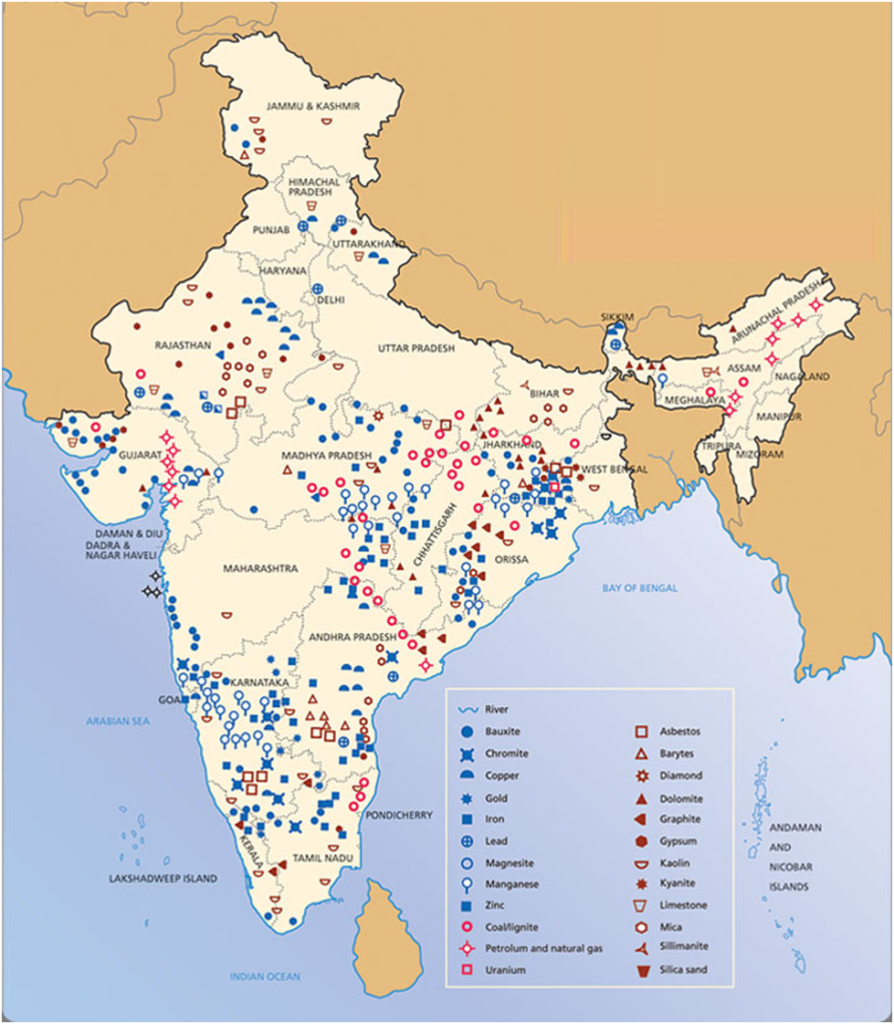India produces as many as 95 minerals, which includes fuel, metallic, non-metallic, atomic and minor minerals. Mining sector is an important segment of the Indian economy.

In India, the minerals are classified as minor minerals and major minerals.
What are Minor Minerals?
According to section 3(e) of the Mines and Minerals (Development and Regulation) Act, 1957 “Minor Minerals” means building stones, gravel, ordinary clay, ordinary sand other than sand used for prescribed purposes, and any other mineral which the Central Government may, by notification in the Official Gazette, declare to be a minor mineral. (For the purposes of this Act, the word “minerals” includes all minerals except mineral oils- natural gas and petroleum).
The term ordinary sand used in clause (e) of Section-3 of the MMDR Act, 1957 has been further clarified in Rule 70 of the Mineral Concession Rule, 1960. It is stated that sand shall not be treated as minor mineral when used for any of the following purposes namely; (i) purpose of refractory and manufacturer of ceramic, (ii) metallurgical purposes, (iii)optical purposes, (iv) purposes of stowing in coal mines, (v) for manufacture of silvicrete cement, (vi) manufacture of sodium silicate and (vii) manufacture of pottery and glass.
What are Major Minerals?
Major minerals are those specified in the first schedule appended in the Mines and Minerals (Development and Regulation) Act, 1957 (MMDR Act 1957) and the common major minerals are Lignite, Coal, Uranium, iron ore, gold etc. It may be noted that there is no official definition for “major minerals” in the MMDR Act. Hence, whatever is not declared as a “minor mineral” may be treated as the major mineral.
Does the major-minor classification has relation with availability of the minerals?
The major-minor classification has nothing to do with the quantum /availability of these minerals, though it is correlated with the relative value of these minerals.
Further, this classification is based more on their end use, rather than level of production, level of mechanization, export and import etc. (eg. Sand can be a major mineral or a minor mineral depending on where it is used; same is the case for limestone.)
India produces as many as 88 minerals which include 4 fuel minerals, 3 atomic minerals, 26 metallic & non-metallic minerals and 55 minor minerals.
What are the respective powers of central and state governments with respect to minor and major minerals?
The central government has the power to notify “minor minerals” under section 3 (e) of the MMDR Act, 1957.
On the other hand, as per Section 15 of the MMDR Act, 1957 State Governments have complete powers for making Rules for grant of concessions in respect of extraction of minor minerals and levy and collection of royalty on minor minerals.
The power to frame policy and legislation relating to minor minerals is entirely delegated to the State Governments while policy and legislation relating to the major minerals are dealt by the Ministry of Mines under Union /Central Government.
Various State Governments have indeed prescribed rules for the grant of mineral concessions in respect of minerals classified as minor minerals under the MMDR Act, 1957.
Thus, as opposed to major minerals, the regulatory and administrative jurisdiction of minor minerals falls under the purview of State governments. These include the powers to frame rules, prescribe rates of royalty, contribution to District Mineral Foundation, the procedure for grant of mineral concessions, regulation of their mining, control of illegal mining etc.
In the case of major minerals, States substantially regulate and develop minerals subject to provisions of the MMDR Act, and after prior permissions from the central government.
List of minor minerals
In addition to the minor minerals specified in Section 3(e) of the MMDR Act, the Central Government has declared the following minerals as minor minerals:
boulder,
shingle,
chalcedony pebbles used for ball mill purposes only,
lime shell, kankar and limestone used in kilns for manufacture of lime used as building material,
murrum,
brick-earth,
fuller’s earth,
bentonite,
road metal,
reh-matti,
slate and shale when used for building material,
marble,
stone used for making household utensils,
quartzite and sandstone when used for purposes of building or for making road metal and household utensils,
saltpeter and
ordinary earth (used or filling or leveling purposes in construction or embankments, roads, railways, building).
Further, Ministry of Mines, on 10 February 2015, notified 31 additional minerals, hitherto under the list of major minerals, as minor minerals. These 31 minerals account for over 55% of the total number of leases and nearly 60% of total leased area. This was done with the intention to “devolve more power to the States, and consequently, expedite the process of mineral development in the country”. The 31 additional minerals notified as minor minerals are:
Agate;
Ball Clay;
Barytes;
Calcareous Sand;
Calcite;
Chalk;
China Clay;
Clay (Others);
Corundum;
Diaspore;
Dolomite;
Dunite/pyroxenite;
Felsite;
Felspar;
Fireclay;
Fuschite Quartzite;
Gypsum;
Jasper;
Kaolin;
Laterite;
Limekankar;
Mica;
Ochre;
Pyrophyllite;
Quartz;
Quartzite;
Sand (Others);
Shale;
Silica Sand;
Slate;
Steatite/Talc/Soapstone.
Must read: Peninsular location of India provides scope for harnessing non-conventional energy resources
External link: https://mines.gov.in/webportal/nationalmineralscenario
PRACTICE QUESTIONS
QUES . Consider the following minerals: UPSC 2020
1 . Bentonite
2 . Chromite
3 . Kyanite
4 . Sillimanite
In India, which of the above is/are officially designated as major minerals?
(a) 1 and 2 only
(b) 4 only
(c) 1 and 3 only
(d) 2, 3 and 4 only
Ans (d)
